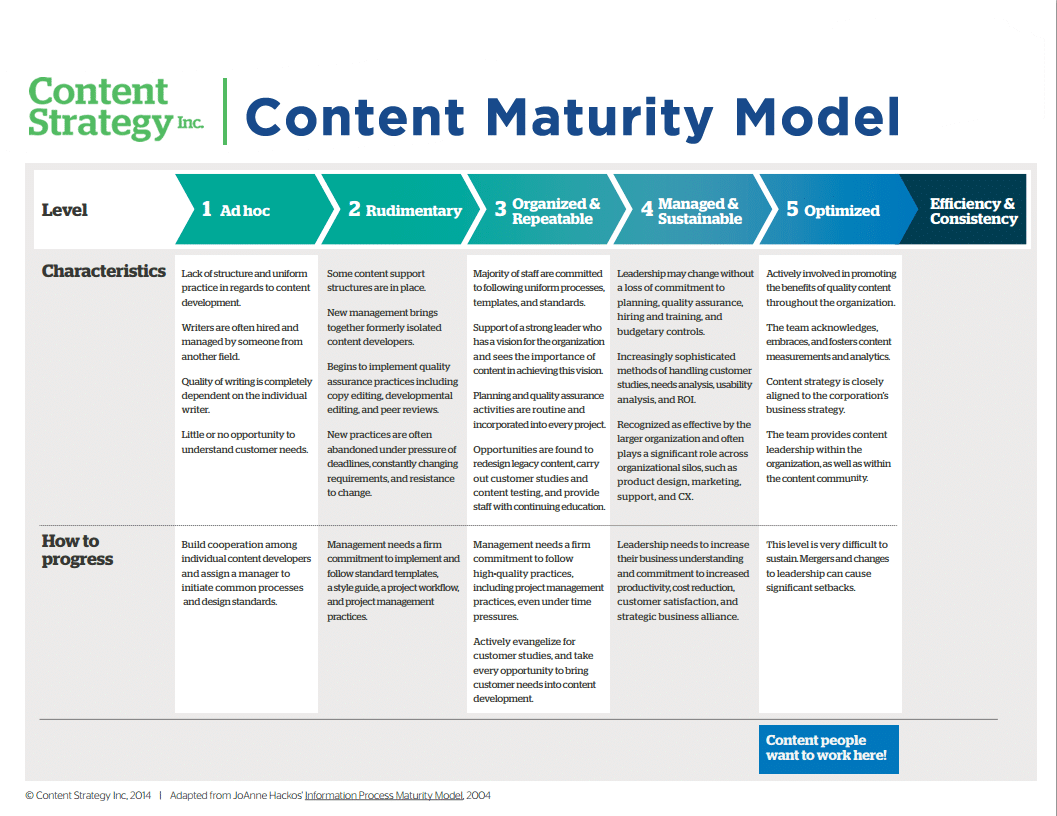Where you are, and where you're going with content
Updated March 2016
The content maturity model is a great way for to you see where your challenges and opportunities are around creating content. You can use it to align stakeholders and team members around a common understanding, and get them excited about evolving their content practices. Most importantly, it provides you with some structure and support to get started.
Download Content Maturity Model (PDF)
We’ve adapted our content maturity model from JoAnn Hackos’s “Information Process Maturity Model”. If you’d like a more in-depth look at this model, or almost anything to do with document management, I highly recommend her excellent book, Information Development: Managing Your Documentation Projects, Portfolio, and People.
Basically, content processes evolve and mature through these 5 phases:
- Ad Hoc
- Rudimentary
- Organized & Repeatable
- Managed & Sustainable
- Optimized
Let’s look at them more closely:
Ad Hoc
Characteristics:
- Lack of structure and uniform practice in regards to content development.
- Writers are often hired and managed by someone from another field.
- Quality of writing is completely dependent on the individual writer.
- Little or no opportunity to understand customer needs.
How to advance to next stage:
- Build cooperation among individual content developers and assign a manager to initiate common processes and design standards.
Rudimentary
Characteristics:
- Some content structures are in place.
- New management brings together formerly isolated content developers.
- Begins to implement quality assurance practices including copy editing, developmental editing, and peer reviews.
- New practices are often abandoned under pressure of deadlines, constantly changing requirements, and resistance to change.
How to advance to next stage:
- Management needs a firm commitment to implement and follow standard templates, a style guide, a project workflow, and project management practices.
Organized and repeatable
Characteristics:
- Majority of staff are committed to following uniform processes, templates, and standards.
- Support of a strong leader who has a vision for the organization and sees the importance of content in achieving this vision.
- Planning and quality assurance activities are routine and incorporated into every project.
- Opportunities are found to redesign legacy content, carry out customer studies and content testing, and provide staff with continuing education.
How to advance to next stage:
- Management needs a firm commitment to follow high-quality practices, including project management practices, even under time pressures.
- Actively evangelize for customer studies, and take every opportunity to bring customer needs into content development.
Managed and sustainable
Characteristics:
- Leadership may change without a loss of commitment to planning, quality assurance, hiring and training, and budget.
- Increasingly sophisticated methods of handling customer studies, needs analysis, usability analysis, and managing return on investment.
- Recognized as effective by the larger organization and often play a significant role across organizational silos such as product design, marketing, support, sales, or training.
How to advance to next stage:
- Leadership needs to increase their business understanding and commitment to increased productivity, cost reduction, customer satisfaction, and alliance to strategic business goals.
Optimized
Characteristics:
- Actively involved in promoting the benefits of quality content throughout the organization.
- The team acknowledges, embraces, and fosters community business analytics.
- Content strategy is closely aligned to the corporation’s business strategy.
- The team provides content leadership within the organization, as well as within the content-development community.
- Content professionals want to work here!
If you find yourself in an optimized environment, keep your fingers crossed! Mergers and changes to leadership can cause any organization to slide back down the maturity ladder.
Can you recognize your organization in one of these phases? Take care to stabilize in one phase before trying to rush too far ahead without creating a solid foundation. Remember, maturing your content team and content practices is a long-term goal. If you have any experiences of evolving your content practices in a similar way, we’d love to hear them!
